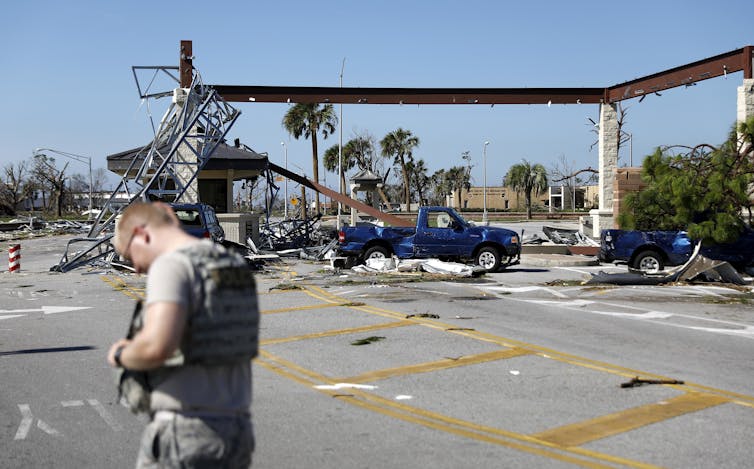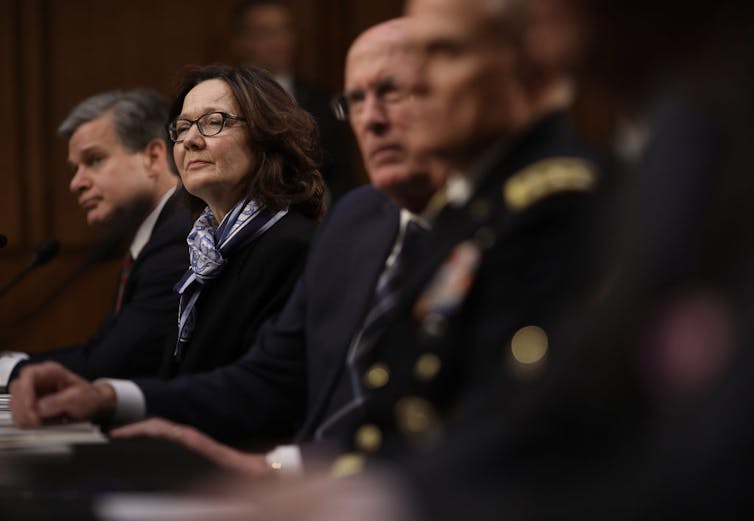With these two extremes polarizing the American political arena, climate policy has come to a near standstill. But as I argue in my new book,“All Hell Breaking Loose: The Pentagon’s Perspective on Climate Change," the U.S. armed forces offer a third perspective that could help bridge the gap.
I’ve studied military and security issues for decades. Although President Trump has called climate change a hoax and worked to reverse the Obama administration’s climate initiatives, senior U.S. military officers have long been aware of warming’s detrimental effects.

A soldier stands guard at the damaged entrance to Tyndall Air Force Base in Panama City, Florida, Oct. 11, 2018, after Hurricane Michael. AP Photo/David Goldman
Military leaders believe climate change seriously threatens U.S. national security. They contend it is stirring up chaos and conflict abroad, endangering coastal bases and stressing soldiers and equipment, which undermines military readiness. But rather than debating the causes of climate change or assigning blame, they focus on how warming undermines security, and on practical steps to slow its advance and minimize damage.
Marines board the amphibious assault ship USS Iwo Jima to provide disaster relief and humanitarian aid to Haiti following Hurricane Matthew, Oct. 8, 2016.
The Pentagon knows about climate impacts
Senior Pentagon officials are familiar with the scientific literature on climate change and know about its expected impacts. Many also have served in climate-ravaged areas of the world, including North Africa, the Middle East and the Pacific Islands.
People in those regions have experienced prolonged and crippling droughts, severe heat waves and catastrophic storms. In many cases, these developments have been accompanied by humanitarian disasters, resource disputes, and armed conflicts - phenomena that impinge directly on the overseas operations of U.S. forces.
“Changing weather patterns, rising temperatures, and dramatic shifts in rainfall contribute to drought, famine, migration, and resource competition" in Africa, General Thomas D. Waldhauser, then commander of the U.S. Africa Command, told the Senate Armed Services Committee in February 2019:
“As each group seeks land for its own purposes, violent conflict can ensue."
FBI Director Christopher Wray; CIA Director Gina Haspel; Director of National Intelligence Dan Coats; and Defense Intelligence Agency director Gen. Robert Ashley testify before the Senate Intelligence Committee on worldwide threats, including climate change, Jan. 29, 2019. Win McNamee/Getty Images
Bases and troops at risk
Military leaders are also contending with climate change impacts on bases, forces and equipment. Hurricanes Florence and Michael in 2018 and heavy inland flooding in the spring of 2019 caused an estimated US$10 billion in damage to Marine Corps Base Camp Lejeune in North Carolina, Tyndall Air Force Base in Florida and Offutt Air Force Base in Nebraska. Scientists widely agree that climate change is making storms like these larger, more intense and longer-lasting.
Threats to other bases - particularly those located along U.S. coastlines, such as the giant naval station at Norfolk, Virginia - are bound to grow as sea levels rise and major storms occur more frequently.
Rising temperatures generate other challenges. In Alaska, many facilities are at risk of collapse or damage as the permafrost on which they sit begins to thaw. In California, wildfires burn on or near key bases. Extreme heat also poses a health risk to soldiers, who must often carry heavy loads during sunlit hours, and to the safe operation of helicopters and other mechanical equipment.


No comments:
Post a Comment